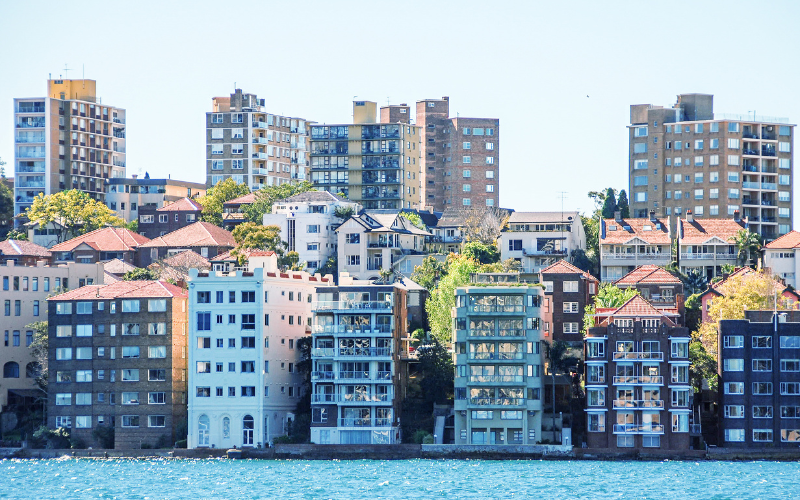.png?language_id=1)
Despite predictions of massive property price falls, home values have climbed for a fourth consecutive month as the slow but steady rebound continues, according to new data.
Since finding a floor in February, national home values rose 1.1% in June, decelerating slightly from a 1.2% gain recorded in
May according to CoreLogic's national Home Value Index.
However, the market still remains -6.0% below peak levels recorded in April 2022. That's the equivalent of the median dwelling value being -$45,771 below a peak of $768,777.
Sydney led biggest gains
Every capital city with the exception of Hobart saw property prices rise in June, with Sydney once again leading the way.
Sydney's median property value rose 1.7% in June - in dollar terms, that's an increase of $4,262 a week.
Over the quarter to June, Sydney dwelling values rose 4.9%.
CoreLogic Head of Research Tim Lawless said the supply and demand imbalance is keeping property prices inflated.
“Through June, the flow of new capital city listings was nearly -10% below the previous five-year average and total inventory levels are more than a quarter below average. Simultaneously, our June quarter estimate of capital city sales has increased to be 2.1% above the previous five-year average," he said.
This supply and demand imbalance has also seen selling conditions turn in favour of vendors rather than buyers.
“Auction clearance rates across the combined capitals held in the high 60% range through June, in stark contrast to late last year when clearance rates were generally below 60%," Mr Lawless said.
"Outside of auction markets, vendors have become less flexible on their price expectations, with capital city discounting rates tightening from -4.3% late last year to -3.6% in June,” Mr Lawless said.
Softer price growth in regions
Home values in regional areas also trended higher, though at a softer pace than their capital city counterparts.
Regional property values saw a 0.5% rise in June, marking four consecutive months of growth.
Mr Lawless said this softer growth trend in the regions aligns with recent shifts in demographic factors post-pandemic.
“After regional population growth boomed through the worst of the pandemic, internal migration trends have normalised over the past year, resulting in less housing demand across regional markets," he said.
"Additionally, housing demand from overseas migration is skewed towards the capital cities rather than the regions.”
This is most evident in regional Victoria where quarterly housing value trends remain negative, declining 0.4% in June to be -1.4% lower over the quarter.
“Value declines were evident across most the SA4 sub-regions of regional Victoria, including the areas adjacent to Melbourne. In June, Geelong home values were down -0.7%, Ballarat values fell - 0.3% and Bendigo was down -0.9%,” Mr Lawless said.
“The weaker conditions across regional parts of the state may be related to a normalisation in migration flows as more regional residents move to the city, along with a substantial narrowing of the affordability gap between regional Victoria and Melbourne through the recent upswing.”
Property price falls, mortgage arrears to come?
Despite an uptick in property prices in June, Mr Lawless said the outlook remains uncertain amid rising interest rates, weaker economic conditions and stretched household balance sheets.
“Higher interest rates and lower sentiment will likely weigh on the number of active home buyers, helping to rebalance the disconnect between demand and supply," he said.
“Forecasts on where the cash rate will land and how long it will stay elevated vary, but it’s likely there is at least one more rate hike to come, potentially more. It’s hard to imagine the recent pace of growth in housing values being sustained while sentiment is close to recessionary lows and the full complement of borrowers are yet to experience the rate hiking cycle in full,” Mr Lawless said.
The Reserve Bank has previously estimated 880,000 fixed rate mortgages are due to expire in 2023, refinancing from mortgages rates of around 2.0% p.a. to higher than 6.0% p.a. which could lead to a 'refinancing tsunami'.
Mr Lawless said as more borrowers are exposed to higher mortgage repayments alongside higher cost of living pressures and little income growth, it's logical to expect a rise in mortgage arrears during the second half of the year.
"We could also see more listing flow onto the market if mortgage stress becomes widespread,” Mr Lawless said.
“At the moment we aren’t seeing any signs that advertised housing stock is rising, at least at a macro level. Some areas, such as Hobart, have seen listings rise to above average levels, but from a low base. This will be a key trend to watch moving forward."
Image via Canva